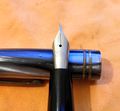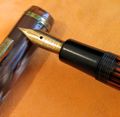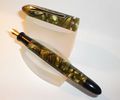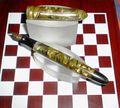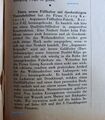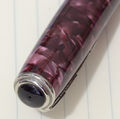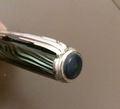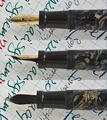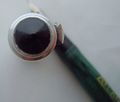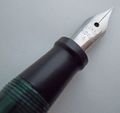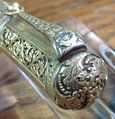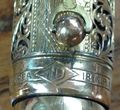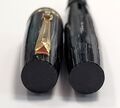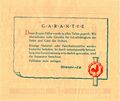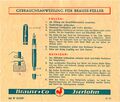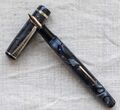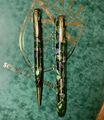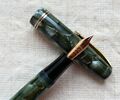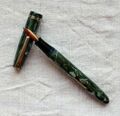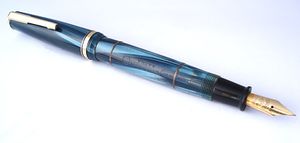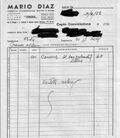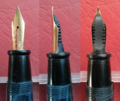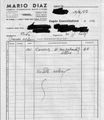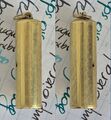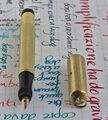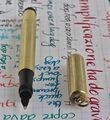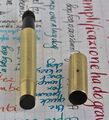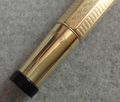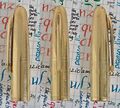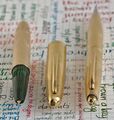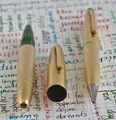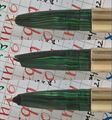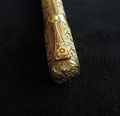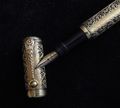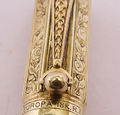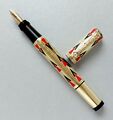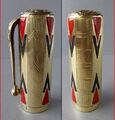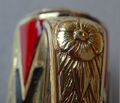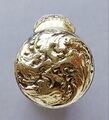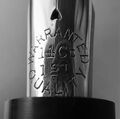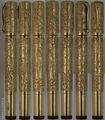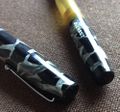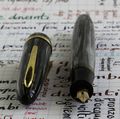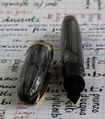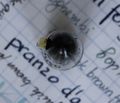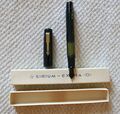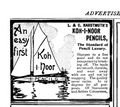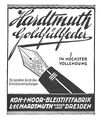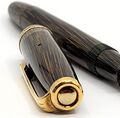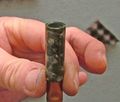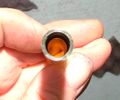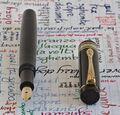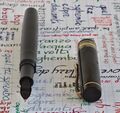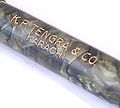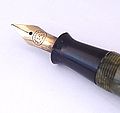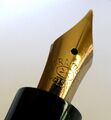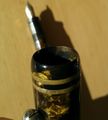Differenze tra le versioni di "Minor brands"
| (4 versioni intermedie di uno stesso utente non sono mostrate) | |||
| Riga 1: | Riga 1: | ||
__NOTOC__ | __NOTOC__ | ||
| − | This page contains the names of a series of minor trademarks of which very little information is available, essentially the name and nationality and little else. The page is basically a collection point for references to these trademarks, and a notebook where you can note the few data relating to them. The information is therefore extremely limited and fragmented. | + | This page contains the names of a series of minor trademarks of which very little information is available, essentially the name and nationality and little else. The page is basically a collection point for references to these trademarks, and a notebook where you can note the few data relating to them. The information is therefore extremely limited and fragmented. Be aware that it contains references just for the pages with an english version, the full list for the original italian pages is mantained in [[Marchi minori|this other page]]. |
| + | |||
{{#ask: [[Category:Small brand]] [[Category:Brands]] | {{#ask: [[Category:Small brand]] [[Category:Brands]] | ||
| Riga 9: | Riga 10: | ||
|0 | |0 | ||
|{{#arraysize:arrName}} | |{{#arraysize:arrName}} | ||
| − | |{{:{{#arrayindex:arrName|{{#var:n}}}}/en}} | + | |<h2>[[{{#arrayindex:arrName|{{#var:n}}}}]]</h2>{{:{{#arrayindex:arrName|{{#var:n}}}}/en}} |
}} | }} | ||
== Note == | == Note == | ||
<references/> | <references/> | ||
Versione attuale delle 11:19, 17 ago 2019
This page contains the names of a series of minor trademarks of which very little information is available, essentially the name and nationality and little else. The page is basically a collection point for references to these trademarks, and a notebook where you can note the few data relating to them. The information is therefore extremely limited and fragmented. Be aware that it contains references just for the pages with an english version, the full list for the original italian pages is mantained in this other page.
Alba
Alba is a Turin-based company whose origins are somewhat uncertain, but that seems to be born by the flight of some Aurora employees who started their own fountain pen production. There are many similarities with Aurora, starting with the name of the company, which also refers to the rising of the sun, and the oval logo with the words "Alba Torino". The company seems to have remained active in the '40s and' 50s.
References: [1]
Available material:
Argument
German company, based in Berlin. Known addresses: Kürassierstrasse 3 and Lichterfelde-West Kadettenweg 2. Full name Argument-Füllhalterfabrik, Georg Karasch, Berlin. The company was founded in the '20s and remained on the market until the '60s. Known models: Argument 33 (safety). In 1932, according to the this advertisement editorial, it introduced the Argument Kristallo model with a transparent tank. Available material:
Atena
The brand Athena is found on some pens of economic range for which the only documentary reference is the presence on a catalogue page of the Aurora of 1940 published in the book of Letizia Jacopini, for which it is generally considered a sub-brand of the Aurora. The pens, although cheap, are of good workmanship, and have, at least in some models, a clip that is practically identical to that found on some models of the series S. of the Summit, which opens all possible speculations about their origin. Available material:
Atlantica
According to Letizia Jacopini the brand was used by the Milan company "Fabbrica Italiana di Penne Stilografiche - La Italianissima di Giuseppe Olivieri". The trademark, however, was deposited in the 1931 (Reg. Gen. N. 43857) by Giacomo Capella, also in Milan, year that we assume, in the absence of more detailed results, as the beginning of the brand. The origins of the company are therefore somewhat uncertain, and the identification with the Italianissima brand is far from obvious, even if a relationship with the company of Olivieri is proven by this flyer for the Milan Fair of 1946.
The production saw well made laminated safety models marked Atlantica, with hard rubber versions whose production is attributed to Montegrappa. The production of the '30s and '40s is characterized by the use of bright colors celluloid with the logo printed on the body. The initial '30s production seems to prefer the button filler while that of the 40's the lever filler.
Available material:
Aurea
Italian brand, on which there is very little historical information. Note for well-made laminated overlays in 18 carat gold (marked 18 KR), and later for low-end pens celluloid. Production often is attributed to Fratelli Cavaliere but in this guide the trademark is shown together with Eridano and Stilus. Materiale disponibile:
Boralevi
The Società anonima Boralevi Milano was a mail-order company based in Milan, Via Pisacane 19, founded in 1921 (as reported in the fourth page of this catalogue). There is little information about the company's history, but catalogues show that it produced several products under its own brand name, including fountain pens, either directly marked Boralevi or marke Ferbor, or also specific models such as Fox 1368.
Due to the presence of an image for the filling system instructions (in this page in a 1931 catalog) identical to the one used by the Helios Silga (this one) it is possible to assume some connection with the latter.
Available material:
Brause
German company, based in Iserlohn. Founded by Carl Bergfeld and brothers Friedrich, Wilhelm and Carl Brause in 1850 in Iserlohn as a nib manufacturer. Designations: Brause & Cie., Brause & Co., Brause & Co. Iserlohn, Brause & Co. Schreibfederfabrik. The company is still on the market today for the production of material and nibs for calligraphy.
The company had some success in the fountain pens production, which began with the reconstruction carried out after the Second World War, in the 50s, particularly for pens intended for the educational market. Its pens were characterized by a blue band placed over the cap ring. Fountain pens production was interrupted in 1970.
Known models: Brause Cito 3030, Brause Schüller 3050. Use of the Cito trademark for nibs, logo of a rooster in a circle.
References: [2]
Available material:
Burnham
English small brand, founded by Harry Burnham around 1920, and active until around 1965/6. Denominated Burnham Pens based in Gloucester Road, London, SE25.
To be completed.
External references: [3], [4], [5] [6], [7]
Available material:
Böhler
The company was founded in 1935 or 1938 (conflicting versions, we assume the later), by Hermann Böhler, one of the two Osmia founders who left the company after the start in 1935 of its acquisition by Faber-Castell, completed in 1951.
External references: [8]
Available material:
CISEA
Italian company. There are no known accurate data on the origins of this company, whose name, as reported by Letizia Jacopini in his book ("La storia della stilografica in Italia") would be an acronym for "Consorzio Italiano Stilografiche e Affini", a group of companies (presumably the district of Settimo Torinese) active in the late '30s and early to mid '40s. In fact the trademark is registered in Turin in 1944 (Reg. Gen. N. 90707) as "Casa Italiana Stilografiche e Affini di Carlo Caramello". He had previously (1939) also recorded the trademarks Amica (Reg. Gen. N. 61381) and Ariana (Reg. Gen. N. 61382). It is unclear whether this is a case of coincidence, but it does not seem likely.
In November 1949 there was the registration with the Chamber of Commerce of Turin (as shown in this excerpt from the fortnightly published by the same) of the "STILOTECNICA di CARAMELLO e C." for fountain pens and related items resale in Turin, Corso Matteotti 10. At the same address in the Guida Paravia of Turin in 1952 is listed "C.I.S.E.A. Casa Italiana Stilografiche e Affini". It is unclear whether this is the opening of a store or a change of business by Carlo Caramello.
There are similarities between the celluloid used for pens branded CISEA and some Olo and ASCO models, which has given rise to the possibility of some connection with the Aurora, but only for the low-end production, an hypothesis supported by the presence of fountain pen marked Amica Cisea, with the Amica trademark, believed to have been used by Aurora for the production of advertising pens, because of the identity of the finish and metal detailing found on these pens with those of Olo.
Available material:
Conté
French company, founded in 1795 by Nicolas-Jacques Conté who invented and patented a new methods of construction of pencils mixing graphite and clay in response to the scarcity of graphite due to the wars against England who were blocking the imports. With his brother he created the Société Conté for the production of pencils and crayons for artists and the homonyms pastels (another Nicolas invention). The company (absorbed by Bic) is still known for the production of these two products. It's know a fountain pens production from the 20s at least until the war. Available material:
Corona Co.
British company, not to be confused with other Corona brands. Based in Manchester, named Corona Co., founded during World War I, and partecipating to an exhibition in 1918. References: [11], [12]
Corona di Mario Diaz
Corona di Mario Diaz was an Italian company based in Milan, active from the mid-thirties. Unfortunately it is not known an exact date for the founding of the company, not to be confused with the same name "Corona" American and English brands. The company was active (at least by some registered trademarks) in the field of mechanical adding machines, but the only registered trademark pertaining to pens is CIP (Reg. Gen. N. 116011).
It is unclear whether there is any relationship with the Corona (Reg. Gen. N. 90853) trademark registered by Luigi Vigorelli in 1945. The production, as evidenced by the order of 1952 shown in the figure at the side, went even after the war, but again it is not known until when the activity has continued.
The company produced good quality celluloid pens, featuring a Corona marked gold nib, with the brand name imprinted on the body, between two circles, in nineteenth-century characters. It's quite interesting, at least in the case of the sample in the figure, the decoration with rings alongside the inscription itself.
References: [13]
Available material:
Ero
</noinclude>
Europa
Italian brand, on which there is very little historical information. It's known for the production of 18 carat gold overlays for safeties (marked 18 KR) of excellent workmanship, with beautiful decorations cantilevered or filigree. The Europa brand is listed on both in the pen and, starting from 1935, on the nib (previously the nibs were marked "Warranted"). According to the reconstruction by Paolo Enrico Demuro[1] the brand, not having been registered (in fact, it does not appear in the Central State Archive database of historical trademarks) would have been used in sharing by Luigi Diani, Cesare Marinai and the Fratelli Cavaliere.
A precise date for the beginning of production is not known with certainty, but according to the historical reconstruction made by Giorgio Fascicolo[2] the first appearance of the brand among the fountain pens illustrated in the Marinai catalog is in that of 1931, being instead absent in the previous ones; for this reason we will assume this year as that of the beginning of production.
It is not clear whether the brand was linked to an independent company or a third party production. The few available documentary sources originate from Cesare Marinai catalogs, where this brand appears along with other related to the Fratelli Cavaliere production, confirmed by some of them having the Linda Darnes punch. The production sold by Marinai reports explicitly the CM punch. Production continued also after the war, with hooded nib pens with laminated metal coating (as in this example).
Riferences: [14]
Available material:
Everest
The company, whose full name is Ditta Stilo-Everest, was based in Turin in via Martiri Fascisti (as reflected by some catalogs) but in this advertisement from 1943 is reported to be in via Card. Maurizio 14 and in this advertisement from 1947 is reported via Superga 25. There is no known foundation date, and the trademark was registered (Reg. Gen. N. 80254) only after the war (1947).
In the Paravia guide for Turin of 1948, in the fountain pen section, the "F.A.V. Fabbricazione Accessori Vari" appears at the same address of Via Card. Maurizio 14, but it is not possible to be sure (given the appearance of another Stilo Everest address in an earlier advertisement) that this is the same company, although it is possible that is it the address of a selling point.
It is not known whether this is a direct manufacturer or just a retailer, but in the models shown in those catalogs seems evident a remarkable similarity with the productions of companies like Montegrappa and SAFIS, and it's also reported a production commissioned to Giacomazzi.
To be completed.
Available material:
Evergood
French company, based in Paris. No known precise data on the origins of this company. Member of the group for the production of Visor Pen.
For Ever
The For Ever brand belongs to the Bolognese company "Ditta Ivo Germano", that registered it in 1954 (Reg. Gen. N. 115909). The production of pens marked "FOR EVER" and "FOUNTAIN-PEN" (on two lines) however was on the market at least from the 20s, with safety and overlays models. The activity of Ivo Germano is brought back, according to Letizia Jacopini, to the "La Stilografica" store in via degli Orefici, which he founded and then was carried on by his son Gianstefano Germano.
The For Ever fountain pens are considered, according to the Emilio Dolcini analysis in his Omas book, mostly a production commissioned to Omas although Letizia Jacopini points out the possibility, especially for safety and overlay pens, whose style and processing does not correspond to the Omas one, that productions could have be done by others. But some sample of Omas and Minerva rebranded Germano pens have been found, as also, less common, some rebranded Ivo or La Stilografica Bologna, confirming without possibility of denial the Omas production in favor of Germano.
The link with Omas is further confirmed by the registration in 1941, two years before the similar recording made by Armando Simoni, of the Permanio brand (Reg. Gen. N. 64310), just for "a metal alloy particularly suitable for the construction of nibs for fountain pens". It is unclear whether the trademark has been sold, although this seems to be the most likely hypothesis, considering the relationship between the two companies.
References: "La storia della Stilografica in Italia" by Letizia Jacopini
Available material:
Giacomazzi
Company history began in 1921 in Settimo Torinese, when the brothers Pietro and Girolamo Giacomazzi, who had worked for Pagliero, began to work on their own to start a company together with Felice Favetta.[3] Initial activities were related to the turning of materials such as ivory, galalith and bone. The attention to fountain pens production seems to be derived from the Pietro son, Dino, that at dissolution of the partnership with Felice Favetta focused the company on this kind of activities.
Giacomazzi worked mainly in contract manufacturing, and no pens bearing its name can be found at least until the 1950s. The only trademark that is definitely its own is Olimpica for which there is a registration in 1944 by Dino Giacomazzi (Reg. Gen. N. 90736), other quality brands which production is attributed to Giacomazzi are Point red (which however was an Ubaldo Massari of Mastilo trademark), Sirium and Sirium Extra.[4]
But according to Pier Luigi Giacomazzi, other commissioned productions were carried out by the company for Everest, Aster, Silpa, Omer, Morans and Aviostil.
Available material:
Hardtmuth
Hardtmuth (or "L & C Hardtmuth"), more commonly known as "Koh-i-Noor Hardtmudt", is a historic producer of pencils and office supplies that was founded in 1790 by Joseph Hardtmudt in Vienna as an earthenware factory, which in 1802 patented a pencil made of clay and coal.[5] Established in the Austro-Hungarian Empire, in 1848 the factory was transferred by the sons of the founder from Vienna to České Budějovice, currently in the Czech Republic. The company introduced in 1889 the line of pencils "Koh-i-Noor", called by the same name of the famous diamond to magnify their quality. To distinguish them, they were painted in yellow, a color that from then has become a classic for pencils.
The Koh-i-Noor brand became the hallmark of the company, that with Faber Castell was one of the leading European pencils producers and is still on the market in the field of stationery and drawing tools. In 1919 the American branch was opened in Bloomsbury, New Jersey, and in 1931 factories in Poland and Romania were opened in cooperation with the then Johann Faber.[6]After World War II the factories in the eastern countries (Poland, Romania and Czechoslovakia) were nationalized, while the American subsidiary separated from the parent company, becoming "Koh-i-noor USA". Only the Austrian company retained its original ownership. In 1957 the Riepe Works ceded to the "Koh-i-noor USA" the rights to the nº US-3020884 of the "Rapidograph". To date, the European rights for the "L. & C. Hardtmuth" and "Koh-I-Noor" trademarks are held by "Crayomine", founded in 1960 in Vaduz.
The company's activities in the fountain pen market derive mainly from the marketing of pens produced by others; in particular it marketed Waterman throughout Europe, for which they were the official agent until World War I. But sometimes there was also a marketing of own-brand fountain pens. Not many details are known about the company's own productions, although there are some advertisements around the 1930s that show own-branded ones but about which very little is known, and there is evidence of relations with the Union Vulpenhouderfabriek in the 1950s.[7]
Refererences: [15], [16], [17], [18], [19], [20]
Available material:
Imperial
German company. Brand name used by "Füllhalter-Fabrik Gerlach & Bezner" based in Leipzig (LEIPZIG und Pardubitz). Active since at least the 40s (by letter of 12.10.1940 on Ebay). After the expropriation of J.Brod by the Nazi it took their production facilities. The activity ended with the transition to the nationalization of the company made in 1945, after the Soviet occupation when the adopted brand was Penco, but the brand "Imperial" survived until 1950 when it was completely eliminated from catalogs.
References: [21]
Available material:
Inoxcrom
The company was founded in 1942 by Manuel Vaqué Ferrandis in Barcelona as Industrial MAVA , initially for the production of steel nibs with a production technique actually called Inoxcrom, which also became the name of the company as of 1946. It later passed to the production of fountain pens for the Spanish market, taking advantage of the absence of duties that instead the Franco regime imposed on foreign production. This is probably the most important producer of Spanish fountain.
Available material:
Italpen
Littoria
Italian company, brand clearly inspired by fascist regime, on which little information is known. The brand seems to have been also used by Columbus for an economic but good quality production. Letizia Jacopini reports of good quality fountain pens branded "Littoria - Stilografica Automatica" with gold nibs stamped "E. V. M.", short for Eugenio Verga - Milan.
It's also known a production of second-tier economic pens simply marked "Littoria", identified by the name followed by a number. Currently little is known about these ones, the reported numbers are: 6, 12, 16, 24, 30, 38.
External references: [25], [26]
Available material:
Mastilo
The Mastilo brand is brought back the production carried out on behalf of a major stationery (but in this guide Massari is indicated as a tobacconist) ship in Turin registered to Ubaldo Massari, via Roma 16, Turin. It's known under this brand a production of Ancora fountain pens, some Maxima rebranded as Mastilo Fountain Pen. On behalf of the same owner there are also the registered trademarks: Stylokopia (Reg. Gen. N. 45108), Red Dot (Reg. Gen. N. 57199) and Tre Stelle (Reg. Gen. N. 64847). In particular Red Dot refers to a model produced in 1934 by Settimo Torinese company Dino Giacomazzi, to which is also attributed the Tre Stelle production.
References: [27]
Available material:
Mengoni
Although the Mengoni name is found on some Minerva models, it is not related to a brand as such but related to the production done for Virginio Mengoni, owner of one of the most important pens and writing materials shop of Milan, placed first in Corso Vittorio Emanuele and then in Via Cantu, whose activities began in 1932.[8]
In the 30s Mengoni joined Edward Russo Webber for the production of Saratoga, for which it is co-holder of the first registration trademark (Reg. Gen. N. 63047), the trademark on the shape of the arrow clip (Reg. Gen. N. 63465) used in earlier models, and the Inco brand (Reg. Gen. N. 63398) used for the Standard version of 40s and for inkwells.
The Saratoga partnership did not last long, at least judging by the subsequent re-registration of the trademark (Reg. Gen. N. 64297) by Webber exclusively in his name. After the war Mengoni still continued his pens production, though branded Saratoga's (Reg. Gen. N. 78484). It is a of low quality production geared towards the market low end, produced presumably in the Settimo Torinese district, with desk pens and piston filler models.
In addition to the Saratoga's, is attributable to Mengoni the F.O.R.T. trademark found on some Minerva models, being the owner (Reg. Gen. N. 63662) of it. Are also attributable to Mengoni the brands: Fonteblu (Reg. Gen. N. 63376), Inch (Reg. Gen. N. 63413) and Coloniale (Reg. Gen. N. 67310). The activity continued until 1957, year of the Mengoni company business end.
Available material:
Merz & Krell
German company, the parent company was born in 1908 from the activities of Friedrich Merz, a pharmacist, and is still active in this field as Merz Pharma. The fountain pens production instead began in 1920, when the two brothers Friedrich and Georg Merz associated themselves to the turner Justus Krell to found Merz & Krell in Bieberau, active immediately with a dozen workers. The Melbi brand was initially adopted (as an abbreviation of Merz & Krell, Bieberau). Later were adopted also the brands Senator and Diplomat. Initial production was fountain pens, holders and celluloid mechanical pencils.
In 1929 the company moved the headquarters at Bahnhofstrasse, in a new building that would accommodate the increased work force of about 150 people. In 1936 it was one of the first German companies to experiment with the use of plastic resin injection purchasing a special machine to produce parts with this technique. In the '60s it began the ballpoint pens production. Active in the production of economic fountain pens, ballpoint pens, in the 80s was one of the main producers of advertising pens, still on the market with the brand Senator which remains one of the leading manufacturers of advertising pens.
References: [28], [29], [30], [31], [32]
Available material:
National
German company, head in Monaco. Known addresses: Hoffmannstr. 43 Fernruf 72077 e 71213. Full name:
Deutsche Füllhalter Werke Gmbh. According to what is reported on this article the company was born from the name change of the previous "Anglo-Americanische-Füllfeder-Gesellschaft", owner of the Angloamer brand. It is not clear, however, the origin of the company, being the latter clearly linked to the activities of Lang, whether as a subsidiary made independent, or separated perhaps during the First World War.
References: [33]
Available material:
Perop
The company was founded in Prague in 1939 by four people, including Emil Kroutl, one of the three founding brothers of the Ripet and František Zeman who worked for the same company as an accountant. The company remained active up to the entrance of Czechoslovakia in the communist regime in 1948.
Esternal references:
Plexor
The brand Plexor was used to market in France the Parker production of at the time of World War II, when the use of an American brand became highly problematic in a situation of open conflict. Production is traced back to the activities of Fernand Laureau who produced the Parker in France under license. It is not clear how long the brand has been maintained, nor if the production was really done by the parent company or independently conducted by the French branch. But it's reported by a French advertising with this brand were produced by the agent on behalf of the French Parker.
Available material:
Standard
Italian brand, on which very little historical information is known.[9] It's known for the production of safety pens with rolled medium quality overlays. There are no known trademarks, or other data related to the origins of the company, and the characteristics of the pens do not present evident similarities with other productions that could provide indications on their possible origin as production on commission; this however has been proven by the finding of some specimens that have the logo of Montegrappa stamped on the cap; it is not clear if this can be the only origin, and it has also been suggested a production by Uhlmann's Eterno, but in this case there is no evidence.
There are also some medium quality celluloid models, with button filling system characterized by the Standard Fountain Pen imprint. Again we do know almost nothing (even if they may be or not related to safety models above), although the use of a full english name could favor the hypothesis of a production made before the promulgation of the fascist laws on forced Italianisation of names.
References: [37]
Materiale disponibile:
Note
- ↑ in an article in Foolish Magazine.
- ↑ in this very detailed presentation of a pen of this brand.
- ↑ the Giacomazzi data come from the Silvio Bertotto book "Settimo Torinese - Una città in punta di penna".
- ↑ but for the latter there is an evidence: on a pen with this brand was found (see this photo) a reference to the utility model N. 22111 registered by the "Fratelli Giacomazzi".
- ↑ although the successors of the American subsidiary proclaim on their site inventors of the first graphite mine, the record belongs to Conté with a patent dated 1785.
- ↑ according to this reference.
- ↑ like the one illustrated in this presentation on the Italian forum.
- ↑ although Letizia Jacopini in her book "La storia della stilografica in Italia" indicates 1934, the company was certainly active earlier, appearing in this page of the 1932-33 edition of the Annuario Italiano that was published in August 1932.
- ↑ the few reported data derived from the Letizia Jacopini book La Storia della Stilografica in Italia and from the referenced discussion.




